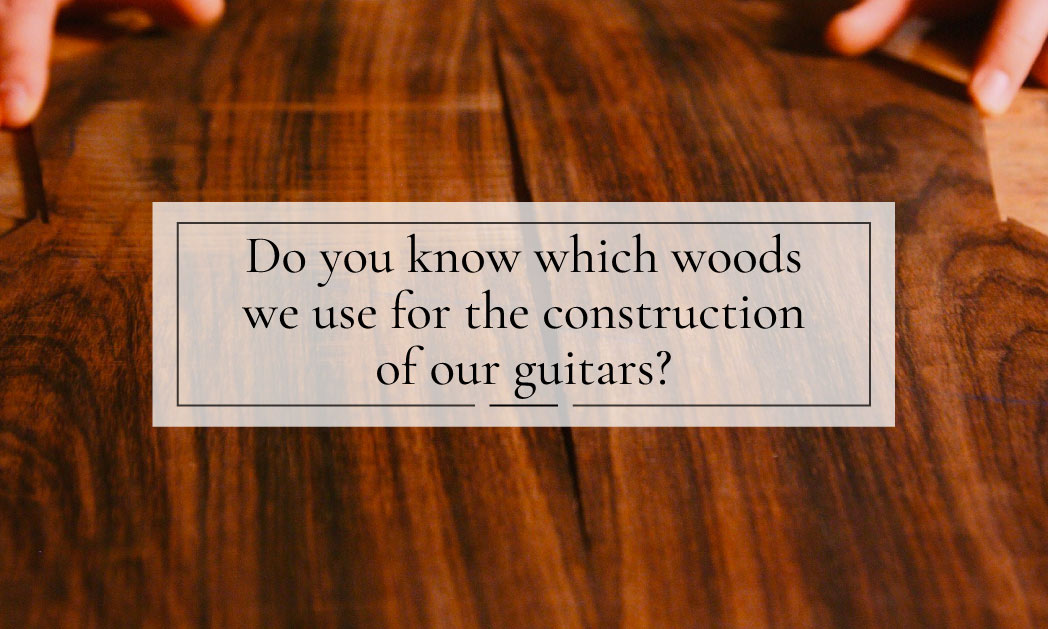As a centenary company, we have inherited from previous generations wood that we have stored since the 1950s. In the construction of our handmade instruments we use wood that have had a natural drying, since this provides stability to changes in humidity and the crystallization of their resins necessary for a higher sound quality. As we consume them, we replace them to promote this way of drying. The natural drying time depends a lot on the thickness of the piece, on the density of the wood, so it is advisable to leave at least 10 years of curing.
On the other hand, the wood we have is correctly cut by the verticality of the growths (wedge-shaped), an ideal method for the instrument to achieve the best sound through the longitudinal grain and obtaining symmetrical pieces, a fundamental characteristic for the top, the floor and the sides. Perpendicularity of the grain is always sought.
The wood that we buy today are obtained from sources committed to responsible trade that promote sustainable forest management under current CITES regulations.
In this video from our Youtube channel, José Enrique Ramírez tells us more about them:
Which woods do we use for our guitars?
The selection, knowledge and storage of wood is very important in order to achieve a quality instrument. For this reason, we talk about the different types of wood we use in the Ramírez guitar workshop.
RED CEDAR (Thuja Plicata)
It was the wood that José Ramírez III discovered by chance in the 1960s. At a time when he had trouble finding Central American cedar (CEDRELA ODORATA), which is the wood we traditionally use for mangoes, he sent one of his officers to one of his officials to buy. He returned assuring that they were offering cedar and that is why José asked him to bring him a sample. When he had it in his hands he was perplexed, obviously it was not the wood that he expected, but they seemed to him the interesting characteristics of it and he wanted to do a test. He put together two pieces that he prepared for a lid and let them dry overnight on a metal plate. The next day the entire surface was completely flat, which is not the case with other wood.
In this wood the same is sought as in the Central European wood used for guitar tops, violin, etc., where it has more quality the more marked, homogeneous and straight the growth lines are, without being too close together or too far apart. This is intended to achieve strength in longitudinal vibrations.
Red cedar is a stable and firm wood that provides a warm and deep sound, which will evolve over time, although from the beginning it will emit a sound that is very close to its total evolution, quite the opposite of spruce, which will take longer to develop. It has an approximate density between 350 and 400 kg / m3. Its popular name leads to confusion, since it is not a type of cedar. It is an evergreen conifer (gymnosperm) that does not resemble the appearance of cedars, since it is neither Cedrella Odorata, nor Cedrus SP, Cedrus Libani, Cedrus Deodara or Cedrud Atlántica. It is very similar to the so-called German spruce (PICEA ABIES).
SPRUCE (Picea Abies)
It is the wood that has been used historically in instrument covers since time immemorial. It has an approximate density of 450 Kg / m3. It is a Conifer of the Pinaceae family.
It gives the instrument a direct and crystalline sound, also sweet, but brighter than that of cedar. The handmade guitar newly constructed with this material will not give the final sound, you will have to work to achieve the ideal result.
It is necessary to indicate that each guitar, no matter the wood with which it is built, will adapt its sound to the way the guitarist plays, as a pen adapts to the hand of a writer.
Also in it, straight and uniform veins are sought, without too much separation between them, ideal for longitudinal vibrations.
INDIAN ROSEWOOD (Dalbergia latifolia)
It has an approximate density between 870 and 900 Kg / m3. It is the most sober of the Dalbergias, but it is much more resistant to changes in humidity, which does not exempt it from proper care of the instrument. Its grain is straight with hardly any drawing. We select the most regular meshes for their stability and sound quality.
We have had wood of this type in storage for at least 70 years. The quality of our Indian rosewood is superior with a more than adequate crystallization to achieve a powerful and balanced sound.
BRAZILIAN ROSEWOOD (Dalbergia Nigra)
Also called Brasilian Jacaranda, Rio Rosewood or Jacaranda from Bahia. It is the most beautiful of all the Dalbergias and for this reason it has been terribly mistreated and exploited, for which its felling was prohibited and the use of wood already cut was regularized as of 1995. Currently it cannot be obtained legally, unless you have a previous stock. We are lucky to keep this wood in our warehouse with a natural aging of 70 years that gives it great sound quality thanks to its crystallization.
Also of all the Dalbergias it is the most crystalline and brittle, so it is important to be very careful with its maintenance and with changes in humidity.
MADAGASCAR ROSEWWOD (Dalbergia Baroni)
We began to use this wood after the ban on Brazilian rosewood in 2000 due to its design and beauty. At present, the felling and export of this wood has also been regulated and it is difficult to obtain, fortunately we have a large amount drying naturally for approximately 20 years.
It is a brown wood with darker meshes and has a density of 920 Kg / m3.
AMAZON ROSEWOOD (Dalbergia Spruceana)
It is a dark brown wood with reddish or purple tones with an approximate density of 1,100 Kg / m3. It is similar to Indian rosewood, although much heavier. The sound qualities make it possible to achieve an instrument with a stable, deep and balanced sound.
COCOBOLO (Dalbergia Retusa)
Of all the dalbergias it is the one with the lightest color, reddish adorned with darker black patterns that give it great beauty. It has good resistance to cracks caused by changes in humidity and time. Its approximate density is between 990 and 1250 Kg / m3. It has the peculiarity that when sawing it, it oxidizes and takes on an orange tone.
With it we get guitars with a sound with much body and powerful bass.
CYPRESS (Cupressus Sempervirens)
It has an approximate density of 400-600 Kg / m3. It is a very light wood with a light yellow color and its grain is straight. It is very pleasant to work with and has a very particular smell. It is very stable with changes in humidity, although that does not mean that the instrument that is made with this wood does not need care.
It is usually used for the so-called White Flamencas with a brighter and husker sound than the guitars called Black Flamencas (with Indian rosewood on the sides and on the back). We use this wood for the double sides (always with solid wood) of our Traditional guitars (which are erroneously known as 1A, which does not mean anything other than a 1st quality guitar, like the rest of our non-2nd hand craft guitars: Simple and Prelude models).
MAPLE (Acer Pseudoplatanus)
It is a white wood that has an approximate density of between 610 and 680 Kg / m3. This wood is highly appreciated for the curls that characterize it and that can be more or less marked. There are two types of maple that we use the flamed (Acer pseudoplatanus) and the bird’s eye (Acer saccharum Marsh. With an approximate density of 630/700 kg / m3).
We use this wood for our historic Tablao Guitar (1913 copy), although it could be added to other models upon request. With this wood we get shades in the sound that give it brilliance, depth and a slightly metallic impression. It was used mainly in old guitars, mainly flamenco. At present it has been recovering in the construction of guitars.
AMERICAN CEDAR (Cedrela Odorata)
It was traditionally known as Honduras cedar. It is the wood that we use for the necks and has an approximate density of between 450 to 600 Kg / m3. It has a light brown color and an adequate weight so that that part of the guitar is not too heavy, and it also has a great stability.
EBONY (Diospyros crassiflora Hiern.)
Ebony is a very dense, rigid and stable wood, when it has had a natural drying, that we use for the fingerboards. It is very resistant to wear. Its color is black, although it may have light spots.
We normally select the blackest wood for our 1st guitars (1A) and the wood with white veins for our 2nd class guitars (2A), although we appreciate the beauty of certain “irregularities” in the wood, and we have planned to make a model with wood that have peculiarities that make them unique.
Its density is approximately between 1000 and 1275 Kg / m3.
By tradition, this wood is used in the fretboards of the highest quality guitars, while rosewood is usually used in lower priced guitars. Many manufacturers tint ebony or rosewood to achieve a dark ebony appearance on the Spanish guitar (classical and flamenco).


